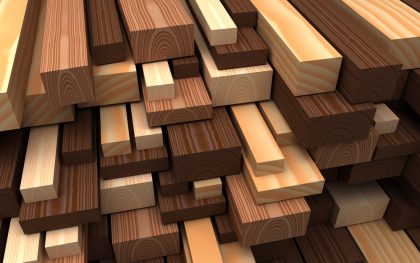The density of wood varies considerably from material to material making it useful for many purposes. Given the many possibilities and ways that wood can be used, can you imagine what life would be like without trees?
Wood is a natural resource that comes from trees, and has been used for centuries in a vast amount of different applications from furniture and decorative items, through to structures and framework. But how do the different properties affect the applications? As you would expect, wood has both physical and chemical properties. Physical properties comprise of the density of wood, the texture, moisture content, shrinkage effect, deformation, splitting, strength, hardness, stiffness and thermal transferability. The appearance of wood is determined by its shade, shine, grain, lustre and structure. Chemical properties refer to the flammability of wood when dry. The chemical composition impacts the characteristics of wood fibre, eventually impacting appropriateness for use.

Density refers to the amount of wood in a unit, per volume of wood. The ratio of dry weight and green volume of the given wood is the basic wood density. More wood content in a specific volume means it has a high density.
The density of wood differs from type to type depending on the tree growth environment, tree species, and the tree area measured for density calculation. The branches usually have a lower wood density compared to the tree trunk. Fast growing trees have a low density. Older and slowly growing trees have a higher wood density.
The main types of wood are Hardwood and Softwood. This does not imply softness or hardness of wood. Both types come from different types of trees so they are classified separately.
Deciduous trees produce hardwood. These trees have covered seeds and shed leaves annually. Conifers provide softwood. These trees have cones and uncovered seeds which fall on the ground.
| Type of wood: Hard | kg/m3 | g/cm3 | lb/ft3 | Notes |
|---|---|---|---|---|
| Walnut | 641-689 | 0.64-0.69 | 40-43 | Walnut wood has high density, consistent texture, and high resistance to shrinkage and bending. It is hard and long lasting but not very heavy. It can be given a better finish because it is non-resinous. Best used for furniture, cabinets and wall panelling. |
| Mahogany | 497-849 | 0.50-0.85 | 31–53 | Mahogany wood exists in a range of densities but is still considered a high density wood. It has a reddish brown shade with fine grains. Best used for constructing boats and cabinets. |
| Maple | 625-753 | 0.63-0.75 | 39–47 | Maple is a hard, strong and finely textured wood with a high density. It is suitable for smoothly carved furniture and floor surfaces. |
| Oak | 593-897 | 0.59-0.90 | 37–56 | Oak wood is medium to high density, and can stay moisture free. This wood is very strong but it can still be bent. It is best used for tool grips, furniture, floor surfaces, tables, boat structures, and coatings. |
| Rosewood | 800-880 | 0.80-0.88 | 50–55 | Rosewood has a high density. It has a brown and reddish shade with grains close together making it difficult to work with. It is commonly used for musical instruments. |
| Cherry | 689-897 | 0.70-0.90 | 43–56 | Cherry wood has a high density with close grains therefore it does not shrink or bend. It gets better with time and is best used for boats, furniture, and cabinets. |
| Balsa | 112-144 | 0.11-0.14 | 7–9 | This is a very soft, low density wood with high strength. It is creamy white and can be used for making models and other woodworking activities. |
| Type of wood: Soft | kg/m3 | g/cm3 | lb/ft3 | Notes |
|---|---|---|---|---|
| Cedar | 368-577 | 0.37-0.58 | 23–36 | Cedar wood has a low density. It is easy to work on its uniform texture. This wood is most suitable for cabinet construction, chests of drawers, roof coverings, cabinets, decks and poles. |
| Pine | 352-849 | 0.35-0.85 | 22–53 | Pine is light weight but the density ranges from low to high depending on the tree. It has a uniform surface and straight grains with a pale yellowish or white colour. It does not bend or twist easily. It is suitable for using in house construction, making furniture, boxes and wall decorations. |
| Fir | 529-737 | 0.53-0.74 | 33–46 | Fir wood has a medium density and consistent texture. It can be used for doors, windows, furniture, frames, surfaces, plywood, and decorations. |
| Hemlock | 657-800 | 0.60-0.80 | 41–50 | Hemlock has a high density and is light weight with uniform grains, making it best used for sheets, frames, boards, beams and construction material. It can be machined easily but needs protection from decay. |
| Spruce | 400-705 | 0.40-0.71 | 25–44 | Spruce wood has a large density range. It is one of the softwoods which can easily decay if left untreated. The wood is light in weight, high strength and very hard. It is suitable for ships poles, stools, millwork, ladders, boxes, crates and also containers. |